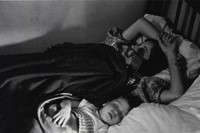Larry Clark tells AnOther about the conceptual genesis of his work
The influence of the photographer and filmmaker Larry Clark on the generation of image-makers that came after him is almost impossible to quantify. In publishing the seminal photographic work Tulsa in 1971, he shone a profound light on the underbelly of America, documenting the suburban drug habits and sex lives of his amphetamine and heroin-addicted friends. He displayed a taste for shooting the kind of subjects that had hitherto been considered entirely taboo, and it's safe to say that without the pioneering work of Clark there would never have been a Nan Goldin, Dash Snow or Ryan McGinley. However, it's important to point out that the man who is perhaps most famous for the harrowing 90s teen movie Kids never actually set out to document willful nihilism or destruction, he was simply capturing the people around him on film, all of whom were living lives that were largely hidden from public view. What Do You Do For Fun? at Simon Lee Gallery, London boasts some of his most iconic images, such as Acid Lower East Side, 1968, and pays homage to his impeccable eye for flawed beauty. Here, he talks to John-Paul Pryor about the conceptual genesis of his work, freeze-framing culture and the searing drama that so often underpins the seemingly mundane.
What Do You Do For Fun? runs until 2 April at Simon Lee Gallery, London.
Text and interview by John-Paul Pryor


